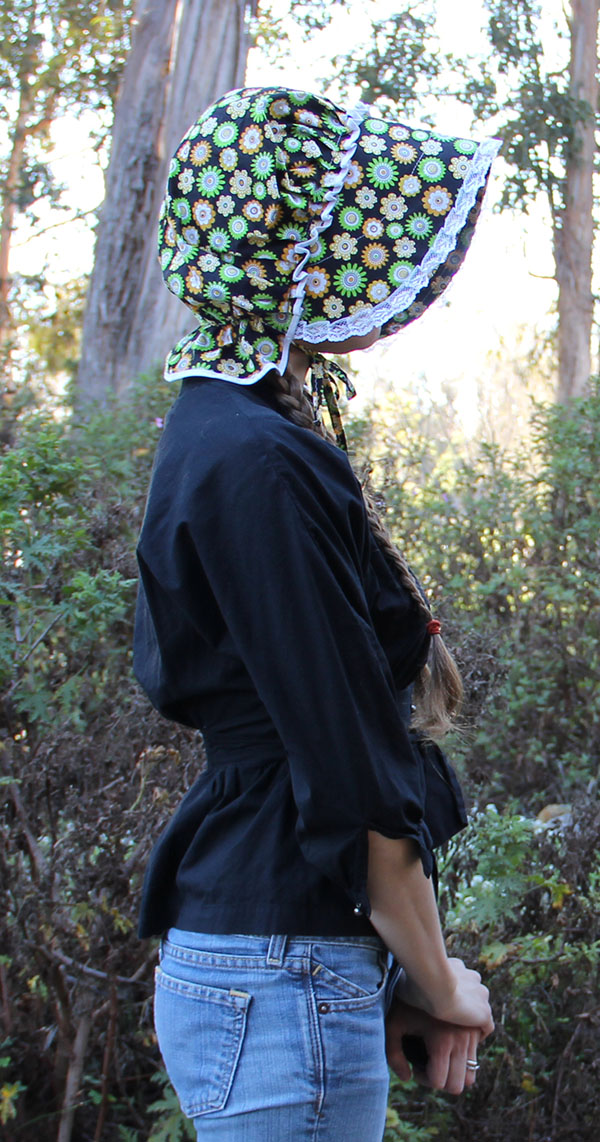Portrait of a Lady (Duff Gordon)
December 13th, 2012
Lucy, Lady Duff Gordon has been on my mind of late. Mostly because I am making yards upon yards of tatted lace trim, loosely based on one of her published patterns. I was curious to know what she’d done to rate her own volume of fashionable tatting patterns, so I looked her up. Color me astonished. Not only was she a leading character of the early 20th-century fashion scene, she was also a woman after my own heart.

- Her maiden name was Sutherland, which may or may not mean a connexion to the Scottish clan of which my ancestors, the Grays, were a sept.
- When faced with financial ruin, she turned to her needle for support, opening a small dressmaker’s shop in turn-of-the-century London.
- She designed the costumes for a London production of The Merry Widow (a favorite of myself and my grandmother) in 1907.
- She was a pioneer of modern fashion culture; her Lucile Ltd. shop featured elegant shopping experiences, complete with live models and afternoon tea. Afternoon tea!!
- Lucy created one-of-a-kind “personality” dresses for her more important clients, spending days getting to know them before making their outfits.
- She, like me, was obsessed with lingerie. In fact, that’s the one part of her label that has survived to this day.
- In addition to tatting patterns, Lucy branched out to design everything from film costumes to car interiors. Yes, car interiors. Those were the days!
Our Lady
December 12th, 2012
Our local hamlet is putting on a Christmas Musicale later this month. In addition to singing a shaky soprano in the choir, I’m also taking part in a girls trio doing Ave Maria. We’re using Schubert’s setting, since it’s probably the most familiar these days — thanks to Frank Sinatra, et al.
What I didn’t know was that Schubert, who composed the iconic melody and cascading arpeggio accompaniment in 1825, didn’t write it for the Latin prayer. It was part of his seven-song cycle for a German translation of Sir Walter Scott’s Lady of the Lake. I’ll pause a moment while that sinks in. Or maybe you already knew, and I am the only one floored by this revelation, courtesy Wikipedia.
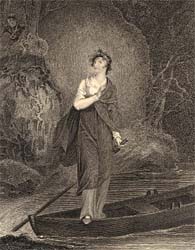
Illustration from Lady of the Lake
Perhaps it hits me particularly hard, since Lady of the Lake is one of my absolute favorites.
He goes to do what I had done,
had Douglas’s daughter been his son…
Doesn’t it just send thrills up your spine? Apparently, Schubert wrote Ellens dritter Gesang (Ellen’s Third Song) for a point in the poem where Ellen prays to the Virgin Mary on behalf of her embattled Highland clan. Here it is in English:
Ave Maria! maiden mild!
Listen to a maiden’s prayer!
Thou canst hear though from the wild;
Thou canst save amid despair.
Safe may we sleep beneath thy care,
Though banish’d, outcast and reviled –
Maiden! hear a maiden’s prayer;
Mother, hear a suppliant child!
Ave MariaAve Maria! undefiled!
The flinty couch we now must share
Shall seem this down of eider piled,
If thy protection hover there.
The murky cavern’s heavy air
Shall breathe of balm if thou hast smiled;
Then, Maiden! hear a maiden’s prayer,
Mother, list a suppliant child!
Ave Maria!Ave Maria! stainless styled.
Foul demons of the earth and air,
From this their wonted haunt exiled,
Shall flee before thy presence fair.
We bow us to our lot of care,
Beneath thy guidance reconciled;
Hear for a maid a maiden’s prayer,
And for a father hear a child!
Ave Maria.
The German pronunciation is a bit beyond me at the moment, but you can bet I’m gonna learn it! I should probably try to dig up the other six songs as well. If this is Ellen’s third, that means at least two more are for soprano…
I’d Walk a Mile…
December 10th, 2012
Actually, I’d walk a lot further than that for one of these babies:
That’s right, a genuine Nilfisk textile vac, with HEPA filter, variable speed motor, and an accessory pack of micro attachments. Price tag: about $2,000.
I sincerely doubt that Santa is going to put one under my tree. Sigh.
Second Armistice Blouse
December 9th, 2012
Armistice blouse number two has much more in common with its early 20th-century inspiration style than my first attempt.

It’s completely hand finished — I used the machine only for the side seams (they are finished by hand with a faux French seam), attaching the collar, pintucking the front panel, and sewing the waist cord. The fabric is a nearly-sheer, thread-dyed cotton gauze pinstripe that I picked up on the clearance rack at Walmart, of all places.
In terms of basic shape, this blouse doesn’t differ much from my first try. It’s still got the kimono sleeves, though much shorter. I also shortened the length so it’s more of a shirt, less of a tunic. And I added the traditional collar. (Though my collar pattern, which began as square cut, a la middy, misfired by the time I decided to make it narrow and rounded. It doesn’t lay flat in the back, causing all sorts of unpleasant rippling.)
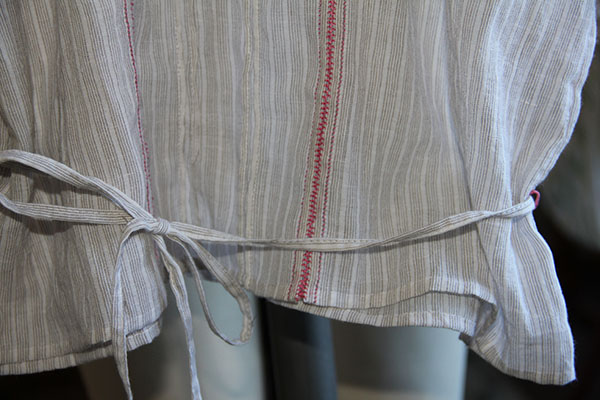
I also reverted to the utilitarian waist tie — on period examples I’ve seen, this tie is usually made from narrow twill tape, never meant to be seen. It contained the blouse’s fullness so it could be neatly tucked into a fitted skirt. Since I don’t intend to wear this blouse (at least not exclusively) with late-Edwardian skirts, I compromised with a self-fabric tie, top-stitched over a double pleat at center back, and held in place with thread loops at the side seams.
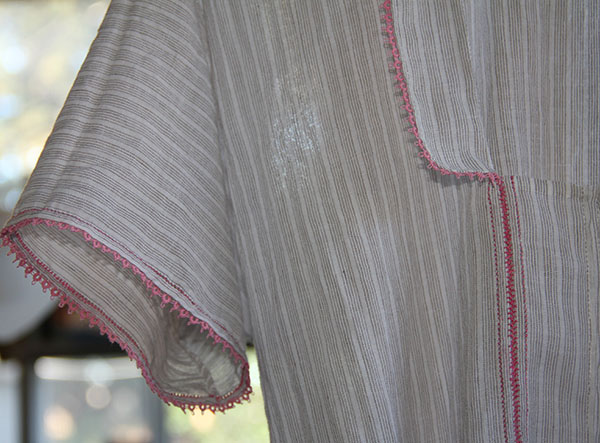
Hand finishing aside, what really took time on this version were the embellishments. They’re pretty restrained compared to some period examples, but I like the understated delicacy. The collar and sleeves are trimmed in tatted lace, made especially for the blouse by yours truly. The sleeves and center panel edges were handkerchief hemmed (a very basic drawn thread stitch). Then, in the case of the center panel, I used matching pink cotton floss to faggot the edges together. You see a lot of this in original garments, though not usually around the center panel, since that was left open on one or both sides. A front closure with scores of teeny tiny buttons meant you didn’t need to pull the blouse over your head, which is much harder to do when you’re wearing a corset…
For modern ease of wearing, not to mention my legendary hatred of buttonholes, I decided to make this an over-the-head style. Version three is already underway. I’m going to adjust the fit a little under the arms, and add pintucking over the shoulders as well, in an attempt to contain some of the bagginess around the bust. And I need to figure out the whole collar thing too. I’m also thinking about doing a little tatted motif to set into the front panel. We’ll see how ambitious I get.
Birthday Bonnets
December 8th, 2012
In celebration of a recent natal anniversary, my affectionate mother sent a package of goodies across the country. The contents proved how well she (and my father, who enclosed a beautiful William Morris-themed notebook) knows me. To witness, this pair of sunbonnets:
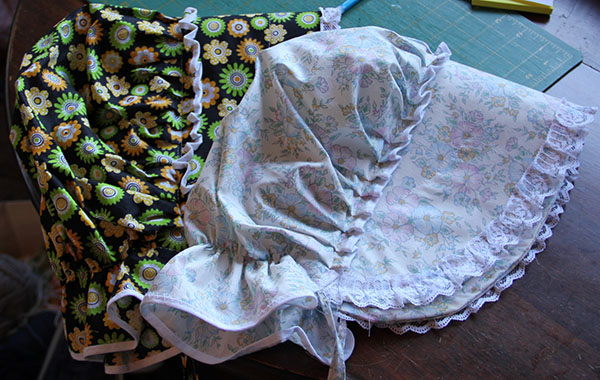
I guess she was tired of hearing me worry about ruining my porcelain complexion in the California sun. Alas, it’s probably too late. Since moving here nearly a year ago, my face and arms have taken on a decidedly berry-like glow. And my hair has changed from mousy brown to some weird mix of gold, brown, and red, with a few pale blond streaks on top.
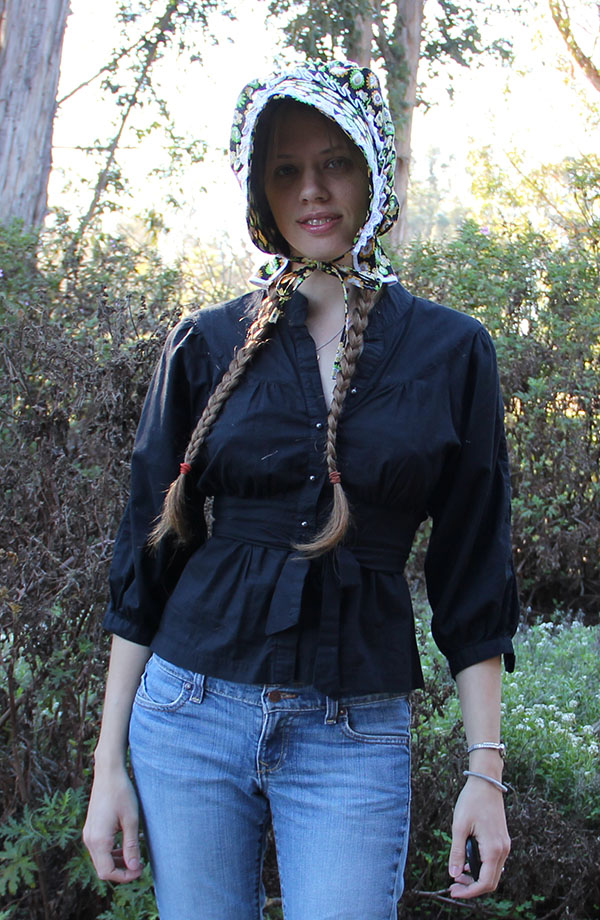
Not many people wear sunbonnets these days. I only knew of one person in NYC who indulged (needless to say, she is a close friend). Alas, I can’t seem to find the post featuring her amazing bonnet — it was black and white striped silk with slats a mile long. Swoon. But I haven’t seen a single soul wearing a sunbonnet out here on the central coast of California. Yet.
My mother tells me she bought my bonnets at a store in south eastern Pennsylvania that caters to Amish and Mennonite communities. Groups that subscribe to traditional or modest dress for religious or social reasons, along with historical reenactors, seem to be the last major proponents of the sunbonnet. A mere century ago, this was definitely not the case. Sunbonnets were necessary work clothing for many American women. Lest I overstep my rather limited knowledge in this area, let me instead recommend The Sunbonnet: An American Icon in Texas, by Rebecca Jumper Matheson. Small world — I had the honor to help organize a book launch party for this title when I worked at an historic house in New York City.
And last but not least, a picture of my new sunbonnet doing what sunbonnets do best: covering my face!
